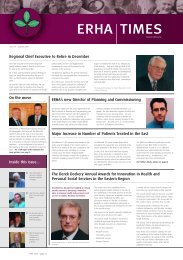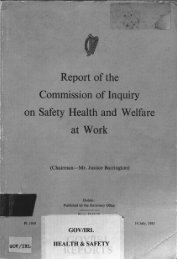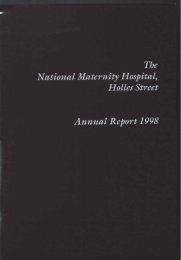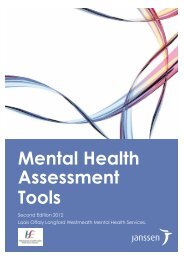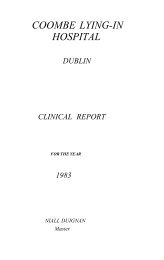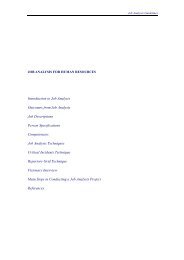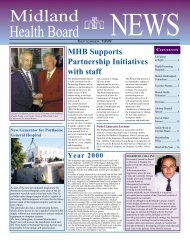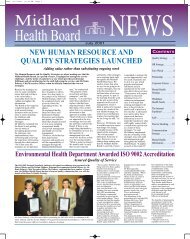MHB News Sept 2004 - Irish Health Repository
MHB News Sept 2004 - Irish Health Repository
MHB News Sept 2004 - Irish Health Repository
You also want an ePaper? Increase the reach of your titles
YUMPU automatically turns print PDFs into web optimized ePapers that Google loves.
8 MIDLAND HEALTH BOARD NEWS ~ SEPTEMBER <strong>2004</strong><br />
<strong>MHB</strong> SAFETY AWARENESS<br />
Welcome to the second edition of our Safety Awareness information articles. Over the<br />
forthcoming issues of the <strong>MHB</strong> news we will be addressing various topics which will<br />
include Child Safety and Fire Safety. In this article our focus is on Fire Safety, with particular<br />
attention on the use of Portable Pressure Fire Extinguishers, with a new competition<br />
for <strong>MHB</strong> staff members!<br />
It is worth knowing that now the summer is as good as over, and we approach the winter<br />
months, that the potential of fire incidents may increase in the Midland <strong>Health</strong> Boards area.<br />
This is due to many reasons for example:<br />
● Colder weather will increase the level of heating appliances used both oil and electrical,<br />
in many cases these units maybe operational 24 hours.<br />
● Darker evenings will increase amount of extra lighting required.<br />
● Additional levels of electrical products been used particularly during the Christmas<br />
period.<br />
Every year in Ireland approximately 50 people die from uncontrollable fire outbreak - mostly<br />
in their own homes, and at work. Those at greatest risk are the under 12’s and over 60.<br />
Every fire has a cause and most often, there’s a common-sense, simple method of prevention.<br />
Careless attention to heaters, cooking equipment and work activities (using electrical equipment)<br />
are leading caused of fire-death and injury.<br />
UNDERSTANDING CAUSES OF FIRE IN IRELAND.<br />
Below highlights the causes of fire deaths throughout Ireland, and focuses on two years 2001<br />
and 2002.<br />
Statistics of Fire Fatalities, in the year 2001 & 2002 Source: National Safety Council.<br />
Summary;<br />
➨ 2001: 63 deaths.<br />
➨ 2002: 51 deaths.<br />
➨ 36% in Winter, 32% in Spring.<br />
Profile of most likely fire victim:<br />
➨ Male (65%), Female (35%).<br />
➨ Alcohol involved (39%).<br />
➨ House fire (67%): Dwelling type, 2-3 storey, (46%).<br />
➨ Fire will happen between 12 am – 6am on a Sunday morning (late Saturday night<br />
may be a factor).<br />
➨ Very likely to NOT have a (working) smoke alarm (82%).<br />
Fires in hospitals pose a major threat to the lives and health of everyone, particularly patients.<br />
Hospitals and health care premises use fire safety strategies based on avoiding fire, rapid detection<br />
and containment and fast evacuation through progressive horizontal evacuation where<br />
necessary are used. An essential part of this safety strategy is the safe use of Fire Fighting<br />
Equipment, i.e. Fire Extinguishers. The following article will provide practical advice, and outline<br />
the safe use of extinguishers. There are many types of fire extinguishers used in the <strong>MHB</strong>,<br />
which are used in different conditions and in various situations depending on the fire in question,<br />
as staff members its therefore very important know when and how to use them.<br />
However in order to use extinguishers you must understand the different fire classifications<br />
that exist, having done so you will know what extinguisher is suitable to use.<br />
FUEL CLASSIFICATIONS<br />
➨ Fires are classified according to the type of fuel that is burning.<br />
➨ You must only use the correct fire extinguisher to attack and extinguish<br />
a particular fire.<br />
➨ It is very important to understand the four different fuel classifications.<br />
Class A: Wood, paper, cloth, rubbish, plastics:<br />
solids that are not metals.<br />
Class B: Flammable liquids:<br />
Petrol, diesel, oil, paint thinners, grease, alcohol, etc.<br />
Class C: Flammable gases such as methane, acetylene,<br />
natural or manufactured.<br />
Electrical: Live electrical equipment as long as it’s plugged in.<br />
The advantage of the above symbols is that they are marked on the extinguishers bodies. This<br />
allows for easy identification of the fire classifications in which they can attack. When choosing<br />
an extinguisher always check its identification markings: text and pictograms. Failure to<br />
do so may result in injury or increasing the fire spread. From the above list can you identify<br />
what fuel classifications you are exposed to in your local work area? One, Two…. In reality<br />
you can be exposed to nearly all of the above, remember there are many hidden risks that<br />
maybe are not obvious to you, air conditioning units, refrigerator units contain pressure gas<br />
and liquid cleaning agents in storage presses can be highly flammable and so on……It’s worth<br />
remembering!<br />
THE SAFE USE OF EXTINGUISHERS<br />
The first thirty seconds after discovering a fire is critical. Within those few moments a decision<br />
to fight a fire must be made and knowing when to fight and when to evacuate the area<br />
can mean the difference between life and death. The following describes how to best use an<br />
extinguisher.<br />
Understanding Fires<br />
In order to have a fire, there must be three elements:<br />
● Fuel —————- something which will burn<br />
● Heat —————- enough to make the fuel burn<br />
● Oxygen ———- air<br />
These three elements are expressed as a triangle, called the Fire Triangle. Remember remove one<br />
or more elements from the fire triangle, will extinguish the fire. That is the principle of how Fire<br />
Extinguishers work, put simply they remove one or more elements from the fire triangle.<br />
Types of Pressurised Extinguishers<br />
1) Water Extinguishers:<br />
Water extinguishers can only be used<br />
on Class A material.<br />
2) Foam Extinguishers:<br />
Foam extinguishers can only be used on<br />
Class A and Class B material.<br />
3) Carbon Dioxide Extinguishers:<br />
Carbon Dioxide Extinguishers can only be used<br />
on Class B and Electrical equipment.<br />
5) Multi Purpose Powder Extinguishers:<br />
Powder extinguishers can be used on all Fuel<br />
Classes A, B, C, and electrical.




